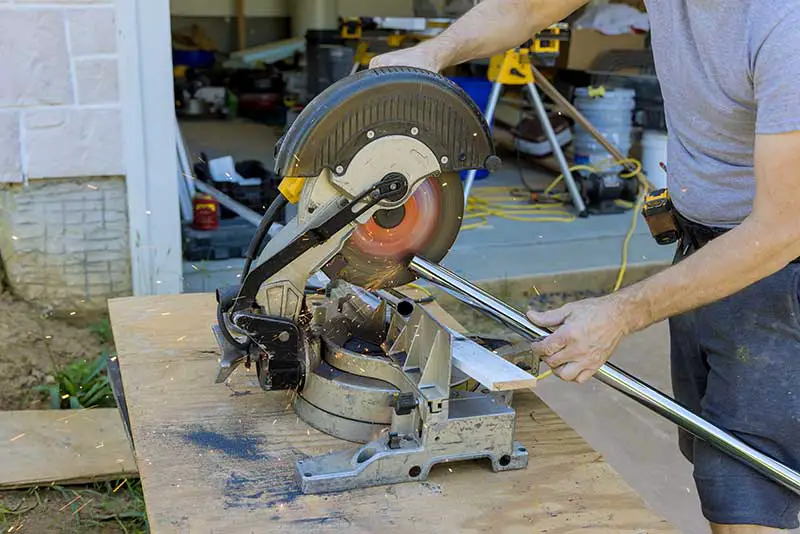A compound miter saw is a versatile power tool that allows users to make precise miter, bevel, and compound cuts simultaneously. It is ideal for woodworking, carpentry, and other tasks that require accurate angled cuts, offering increased versatility compared to a standard miter saw.

A compound miter saw is a versatile power tool that allows users to make precise angled cuts in various materials, such as wood, plastic, and metal. It is an advanced version of a standard miter saw, with additional features that enable it to make both miter and bevel cuts simultaneously.
Key Features of a Compound Miter Saw
Miter Cuts
A compound miter saw can make miter cuts by pivoting the saw head horizontally. This feature allows users to create precise angled cuts across the width of the material.
Bevel Cuts
Unlike a standard miter saw, a compound miter saw can also make bevel cuts by tilting the saw head at an angle to the vertical plane. This feature enables users to cut angles along the thickness of the material.
Compound Cuts
A compound miter saw can make both miter and bevel cuts simultaneously, hence the name “compound.” This feature is particularly useful for creating complex angles, such as those required for crown molding or intricate trim work.
Sliding Mechanism (Sliding Compound Miter Saw)
Some compound miter saws come with a sliding mechanism that allows the saw head to move along a rail, increasing the cutting capacity. These saws, known as sliding compound miter saws, can handle wider materials and are often preferred by professionals for their added versatility.
Benefits of a Compound Miter Saw
- Versatility: The ability to make miter, bevel, and compound cuts enables users to tackle a wide range of projects, from basic woodworking tasks to complex carpentry jobs.
- Precision: Compound miter saws are designed for accurate cuts, making them ideal for creating tight-fitting joints and seamless connections.
- Time-saving: The compound miter saw’s ability to make multiple cuts in a single pass can significantly reduce the time spent on projects, especially when working with intricate cuts and angles.
- Ease of use: Compound miter saws often come with adjustable fences, built-in laser guides, and other features that make setting up and executing cuts a simple and efficient process.
Common Applications of a Compound Miter Saw
- Trim work: Compound miter saws are ideal for cutting baseboards, crown molding, and other trim materials.
- Framing: The saw’s precision and versatility make it suitable for cutting framing components, such as studs and rafters.
- Furniture making: Compound miter saws can be used to create precise angles for furniture components, such as table legs and cabinet frames.
- Picture framing: The saw’s ability to make accurate miter and bevel cuts makes it a popular choice for cutting picture frame moldings.
| Feature | Benefit |
|---|---|
| Miter cuts | Precise angled cuts |
| Bevel cuts | Angled cuts along thickness |
| Compound cuts | Complex angles |
| Sliding mechanism | Increased cutting capacity |
This table summarizes the key features and benefits of a compound miter saw.
Selecting the Right Compound Miter Saw
When choosing a compound miter saw, consider the following factors to ensure you select the right tool for your needs:
1. Size and Cutting Capacity
Compound miter saws come in various sizes, typically ranging from 7-1/4 inches to 12 inches in blade diameter. Larger saws can handle wider and thicker materials, so consider the size of the materials you plan to work with before making a decision.
2. Single or Dual Bevel
A single bevel compound miter saw can only tilt in one direction, whereas a dual bevel saw can tilt in both directions, allowing for faster and more convenient bevel cuts. Consider a dual bevel model if you work with complex angles regularly.
3. Sliding or Non-Sliding
As mentioned earlier, a sliding compound miter saw has a sliding mechanism that increases its cutting capacity, enabling it to handle wider materials. If you anticipate working with larger workpieces, a sliding model may be worth considering.
4. Additional Features
Look for additional features that can enhance the usability and precision of the saw, such as built-in laser guides, adjustable fences, dust collection systems, and electric brakes.
Compound Miter Saw Safety Tips
As with any power tool, safety should always be a priority when using a compound miter saw. Keep these safety tips in mind:
- Read the manual: Familiarize yourself with the manufacturer’s instructions for your specific saw model.
- Wear safety gear: Use safety goggles, ear protection, and gloves when operating the saw.
- Secure the workpiece: Ensure the material is firmly clamped or held in place before making a cut.
- Keep your hands clear: Maintain a safe distance between your hands and the blade while the saw is in operation.
- Maintain the saw: Regularly inspect and clean the saw to ensure optimal performance and safety.
Conclusion
A compound miter saw is a versatile and valuable addition to any workshop, offering precise miter, bevel, and compound cuts with ease. By considering factors such as size, cutting capacity, bevel options, and additional features, you can select the right compound miter saw for your needs. Remember to prioritize safety when operating the saw, and you’ll be well-equipped to tackle a wide range of projects with precision and efficiency.
